国际经济学名词解释双语
国际经济学重点名词解释

●Arbitrage:The purchase of a currency in the monetary centerwhere it is cheaper for immediate resale in the monetary center where it is more expensive in order to make a profit.( buying at a low price and selling at a high price for a profit.)●Monetary approach: Economists believe that the money supplydetermines the price level in the long run .●Hyperinflation :occurs when a country experiences veryhigh and usually accelerating rates of price inflation, rapidly depreciating the real value of the local currency, and causing the population to minimize their holdings of the local money.●contractionary monetary policy :is one that reducesthe surplus of available assets. This is brought into action and controlled by a central bank or fiscal body appointed by thegovernment. Its primary purpose is to control inflation.●Purchasing power parity:The notion that the ratio betweendomestic and foreign price levels should equal the equilibrium exchange rate between domestic and foreign currencies.●Devaluation:A deliberate downward adjustment to a country'sofficial exchange rate relative to other currencies.●Appreciation :The increase in value of an asset. Unless you areshort selling, appreciation is always a good thing!●Overshooting:A phenomenon in economics used to explainwhy exchange rates are more volatile than would be expected.●exchange rate: is the rate between two currencies at whichone currency will be exchanged for another. It is also regarded as the value of one country’s currency in terms of another currency.●Balance of Payment:is defined as, "Systematic record of all economictransactions between the residents of a foreign country" Thus balance of payments includes all visible and non-visible transactions of a country during a given period, usually a year. It represents a summation of country's current demand and supply of the claims on foreign currencies and of foreign claims on its currency.[●Speculation:is the practice of engaging in risky financialtransactions in an attempt to profit from short or medium term fluctuations in the market value of a tradable good such as a financial instrument, rather than attempting to profit from the underlying financial attributes embodied in the instrument such as capital gains, interest, or dividends.●Sterilization:a term referring to central bank operationsaimed at neutralizing foreign exchange operations' impact on domestic money supply and to generally offset potentially adverse consequences of large capital flows.● Expansionary monetary policy :is when a central bank uses itstools to stimulate the economy. This usually means lowering the rate to increase the money supply. This action increases liquidity, giving banks more money to lend.●Optimum currency area :is a geographical regionin which it would maximize economic efficiency to have the entire region share a single currency.●floating exchange rate: is a type of exchange-rate regime inwhich a currency's value is allowed to fluctuate according to the foreign-exchange market. A currency that uses a floating exchange rate is known as a floating currency. A floating currency is contrasted with a fixed currency.●marginal propensity to import:refers to the change inimport expenditure that occurs with a change in disposable income (income after taxes and transfers).●Managed floating system : is the current international financialenvironment in which exchange rates fluctuate from day to day, but central banks attempt to influence their countries' exchange rates by buying and selling currencies.●Vehicle currency :is a currency demonstrating the convenience to allparties of picking one or two leading currencies used by smaller countries as focal points for trading .It . in any center of foreign exchange trading,most business is carried on in only a few foreign currency,●The official reserve transactions account:it consists ofcentral transactions in international reserve assets:gold,foreign exchange reserves,credits issued by the international monetary fund,and special drawing rights.central banks hold these reserve assets to back up the liabilities they issue.●Exchange rate overshooting :is defined as the case in which theinitial depreciation rate is larger than the long-run depreciation rate ,that is the case in which the post-crisis exchange rate is lower than the short-run level.。
国际经济学之名词解释
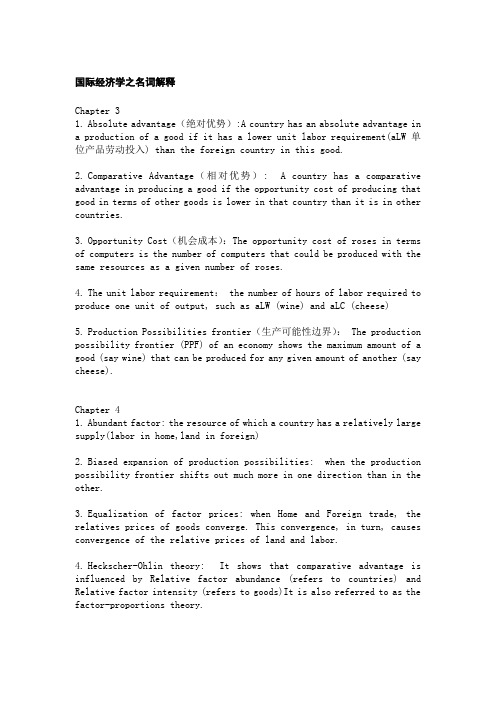
国际经济学之名词解释Chapter 31.Absolute advantage(绝对优势):A country has an absolute advantage ina production of a good if it has a lower unit labor requirement(aLW 单位产品劳动投入) than the foreign country in this good.parative Advantage(相对优势): A country has a comparative advantage in producing a good if the opportunity cost of producing that good in terms of other goods is lower in that country than it is in other countries.3.Opportunity Cost(机会成本):The opportunity cost of roses in terms of computers is the number of computers that could be produced with the same resources as a given number of roses.4.The unit labor requirement: the number of hours of labor required to produce one unit of output, such as aLW (wine) and aLC (cheese)5.Production Possibilities frontier(生产可能性边界): The production possibility frontier (PPF) of an economy shows the maximum amount of a good (say wine) that can be produced for any given amount of another (say cheese).Chapter 41.Abundant factor: the resource of which a country has a relatively large supply(labor in home,land in foreign)2.Biased expansion of production possibilities: when the production possibility frontier shifts out much more in one direction than in the other.3.Equalization of factor prices: when Home and Foreign trade, the relatives prices of goods converge. This convergence, in turn, causes convergence of the relative prices of land and labor.4.Heckscher-Ohlin theory: It shows that comparative advantage is influenced by Relative factor abundance (refers to countries) and Relative factor intensity (refers to goods)It is also referred to as the factor-proportions theory.5.Scarce factor: in that country, and the resource of which it has a relatively small supply( land in Home, labor in foreign)Chapter 51.Biased growth: Biased growth takes place when TT (a country’s production possibility frontier) shifts out more in one direction than in the other.2.Isovalue lines(等价线) : It is a line along which the market value of output is constant by an equation of the form: PCQC + PFQF = V. The higher values of output, the farther out an isovalue line lies.3.Indifference curves(无差异曲线): Each traces(表明) a set of combinations of cloth (C) and food (F) consumption that leave the individual equally well off.4.Terms of trade : The price of the good a country initially exports divided by the price of the good it initially imports.5.Export-biased(出口偏向) growth: home experiences growth biased toward cloth and disproportionately expands a country’s PP in the direction of the good it exports.6.Import-biased growth (进口偏向): It disproportionately expands a country’s PP in the direction of the good it imports.7.Immiserizing growth (贫困化的经济增长): A situation where export-biased growth by poor nations can worsen their terms of trade so much that they would be worse off than if they had not grown at all.8. Import tariffs are taxes levied on imports9.External price: goods are traded internationally10.Export subsidy(出口补贴):payments given to domestic producers who sell a good abroad.Chapter 61.Dumping(倾销): the most common form of price discrimination in international trade.2.External economies of scale(外部规模经济) :the cost per unit depends on the size of the industry but not necessarily on the size of any one firm.3.Infant industry argument: the argument for temporary protection of industries to enable them to gain expensive.4.Internal economies of scale(内部规模经济) the cost per unit depends on the size of an individual firm but not necessarily on that of the industry.5.Interindustry trade: the exchange of manufactures for food.6.Intraindustry trade: the exchange of manufactures for manufactures.7.Knowledge spillovers: Knowledge is one of the important input factors in highly innovative industries.bor market pooling(劳动力共享市场): A cluster of firms can createa pooled market for workers with highly specialized skills.9.Oligopoly(寡头垄断) : There are several firms, each of which is large enough to affect prices, but none with an uncontested monopoly.10.Price discrimination: The practice of charging different customers different prices.Chapter 71.Direct foreign investment: international capital flows in which a firm in one country creates or expands a subsidiary in another.2.Factor movements: international movements of factors of production.3.Intertemporal production possibility frontier跨时生产可能性: Imagine an economy that consumes only one good and will exist for only two periods, which we will call present and future.Chapter 81.Ad valorem tariff(从价关税): taxes that are levied as a fraction of the value of the imported goods.2.Consumption distortion loss(消费扭曲损失): a tariff leads consumers to consume too little of the good.3.Export restraint: Limit the quantity of exports.4.Nontariff barriers: modern governments usually prefer to protect domestic industries.5.Production distortion loss(生产扭曲损失):the tariff leads domestic producers to produce too much of this good.6.Specific tariff:(从量关税):taxes that are levied as a fixed charge for each unit of goods imported.Chapter 91.Optimum tariff (最优关税):by convention the phrase optimum tariff is usually used to refer to the tariff justified bu a terms of trade argument rather than to the best tariff given all possible considerations.。
国际经济学名词解释
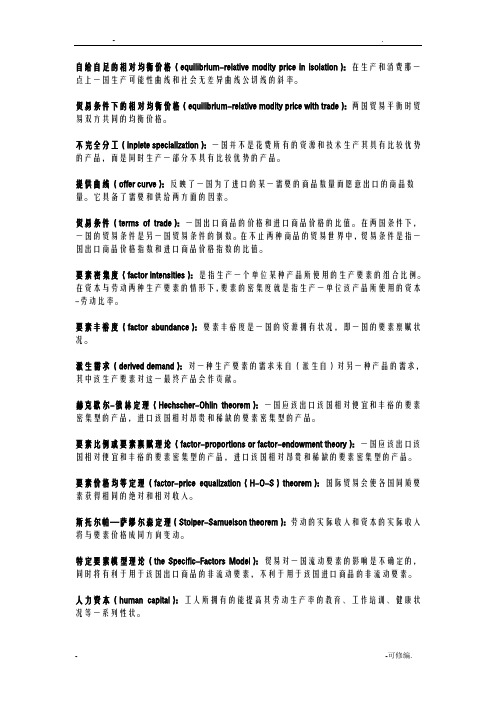
自给自足的相对均衡价格(equilibrium-relative modity price in isolation):在生产和消费那一点上一国生产可能性曲线和社会无差异曲线公切线的斜率。
贸易条件下的相对均衡价格(equilibrium-relative modity price with trade):两国贸易平衡时贸易双方共同的均衡价格。
不完全分工(inplete specialization):一国并不是花费所有的资源和技术生产其具有比较优势的产品,而是同时生产一部分不具有比较优势的产品。
提供曲线(offer curve):反映了一国为了进口的某一需要的商品数量而愿意出口的商品数量。
它具备了需要和供给两方面的因素。
贸易条件(terms of trade):一国出口商品的价格和进口商品价格的比值。
在两国条件下,一国的贸易条件是另一国贸易条件的倒数。
在不止两种商品的贸易世界中,贸易条件是指一国出口商品价格指数和进口商品价格指数的比值。
要素密集度(factor intensities):是指生产一个单位某种产品所使用的生产要素的组合比例。
在资本与劳动两种生产要素的情形下,要素的密集度就是指生产一单位该产品所使用的资本-劳动比率。
要素丰裕度(factor abundance):要素丰裕度是一国的资源拥有状况,即一国的要素禀赋状况。
派生需求(derived demand):对一种生产要素的需求来自(派生自)对另一种产品的需求,其中该生产要素对这一最终产品会作贡献。
赫克歇尔-俄林定理(Hechscher-Ohlin theorem):一国应该出口该国相对便宜和丰裕的要素密集型的产品,进口该国相对昂贵和稀缺的要素密集型的产品。
要素比例或要素禀赋理论(factor-proportions or factor-endowment theory):一国应该出口该国相对便宜和丰裕的要素密集型的产品,进口该国相对昂贵和稀缺的要素密集型的产品。
国际经济学名词解释1

Laissez-faire(自由放任政策):The policy of minimum government interference in or regulation of economic activity, advocated by Adam Smith and other classical economists.自由放任政策:使政府最少地干预经济或规范经济活动的政策,是亚当斯密和其他古典经济学家所奉行的政策。
Complete specialization(完全专业化):The utilization of all of a nation’s resources in the production of only one commodity with trade. This occurs under constant costs.完全专业化:使用一国的所有资源来生产一种产品以供贸易。
这经常在不变成本条件下发生。
P78Increasing opportunity costs(机会成本递增):The increasing amounts of one commodity that a nation must give up to release just enough resources to produce each additional unit of another commodity. This is reflected in a production frontier that is concave from the origin.机会成本递增:一国要生产一件另一种产品而必须放弃生产某种产品数量的增加。
这也反映于生产可能性曲线凹向原点。
Marginal rate of transformation(边际转换率)The amount of one commodity that a nation must give up to produce each additional unit of another commodity. This is another name for the opportunity cost of a commodity and is given by the slope of the production frontier at the point of production.边际转换率:一国要生产一件某种产品而必须放弃的另一种产品的数量。
名词解释英文国际经济学
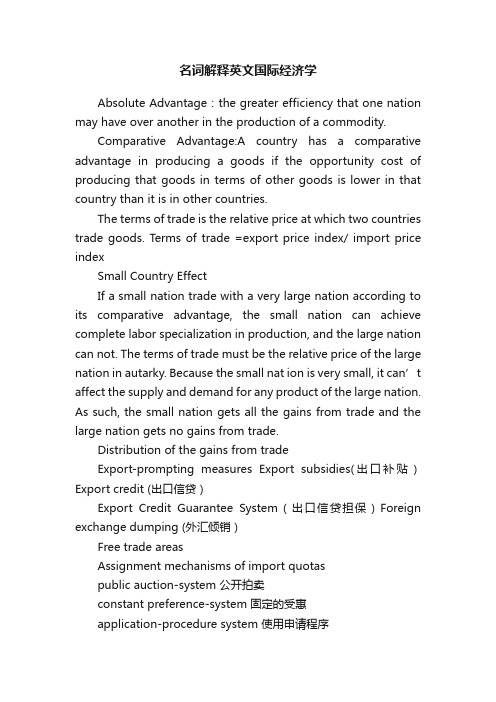
名词解释英文国际经济学Absolute Advantage:the greater efficiency that one nation may have over another in the production of a commodity.Comparative Advantage:A country has a comparative advantage in producing a goods if the opportunity cost of producing that goods in terms of other goods is lower in that country than it is in other countries.The terms of trade is the relative price at which two countries trade goods. Terms of trade =export price index/ import price indexSmall Country EffectIf a small nation trade with a very large nation according to its comparative advantage, the small nation can achieve complete labor specialization in production, and the large nation can not. The terms of trade must be the relative price of the large nation in autarky. Because the small nat ion is very small, it can’t affect the supply and demand for any product of the large nation. As such, the small nation gets all the gains from trade and the large nation gets no gains from trade.Distribution of the gains from tradeExport-prompting measures Export subsidies(出口补贴)Export credit (出口信贷)Export Credit Guarantee System(出口信贷担保)Foreign exchange dumping (外汇倾销)Free trade areasAssignment mechanisms of import quotaspublic auction-system 公开拍卖constant preference-system 固定的受惠application-procedure system 使用申请程序Export subsidies and its’ economic effect The implication of export subsidesA quota is a direct quantitative restriction on the amount of a commodity allowed to be imported or exported (in the form of voluntary export restraints).As tariffs were negotiated down during the postwar period, then import quotas have been widely used by developed nations to protect their agriculture and by developing nations to stimulate import substitution of manufactured products and for balance-of-payments reasons.Other non-tariff barriers Industrial policy ,Government procurement Dumping and anti-dumping T echnical barriers to tradeLabor and environmental standards,Transportation costs and trade The Theory of Protective Trade 1.Merchantilism 2. The optimum tariff theory3.The infant industry argument4. Keynes’ protective trade theory5. Strategic trade policy6. The political economy of protectionism幼稚产业论 a national economy can be divided into five stages. In an early stage of industrialization required tariff protection to stimulate development.Infant industries are those that are not strong enough to survive open competition and have the growth potential. How toJudge。
国际经济法名词解释双语

国际经济法名词解释双语
国际经济法是指规范国际经济关系的法律体系。
下面是一些国际经济法的常见名词以及其解释:
1.自由贸易:指国家在相互协议下放宽或取消贸易壁垒,实现商品和服务的自由流通。
2.关税:指对进口或出口商品课征的税费,可以用于保护国内产业或筹集国家财政收入。
3.贸易协定:国家或地区之间为了促进贸易流通而达成的协议,通常包括关税优惠、市场准入等方面的规定。
4.贸易保护主义:一种国家采取的措施,旨在限制进口、保护本国产业,如征收高关税或采取非关税壁垒。
5.最惠国待遇:指国与国之间互相给予最有利条件的待遇,不得对某一国家或地区施加歧视性措施。
6.国民待遇:指对国内企业和外国企业一视同仁地对待,不得对外国企业采取歧视性措施。
7.金融自由化:指国家为了促进国际金融流动而取消金融市场上的限制,提供更多的金融服务和产品选择。
8.知识产权:指由个人或企业独立创造而获得的知识或创新成果的法律保护,包括专利、商标、版权等。
9.争端解决机制:是指国家之间解决国际经济争端的方式,可以通过谈判、调解、仲裁或诉讼等方式进行解决。
此外,国际经济法还涉及跨国公司、外国投资、禁止垄断和不正当竞争等课题。
国际经济法的主要目标是促进全球经济的稳定和有序发展,保护各国的商业利益,并加强国家之间的经济合作和互信。
国际经济法的发展也受到国际经济体系和国际组织的影响。
《国际经济学》名词解释(第01章---第06章)

1.Production Possibility Frontier(生产可能性边界)Production Possibility Frontier shows various alternative combinations of two goods that a nation can produce when all of its factor inputs are used in their most efficient manner.8.Terms of Trade(贸易条件)Terms of trade of a nation are defined as the ratio of the price of its export commodity to the price of its import commodity.9.An improvement in a nation’s terms of trade(贸易条件改善)An improvement in a nation’s terms of trade requires that the prices of its exports rise relative to the prices of its imports over the given time period. A smaller quantity of export goods sold abroad is required to obtain a given quantity of imports.10.A deterioration in a nation’s terms of trade(贸易条件恶化)A deterioration in a nation’s terms of trade is du e to a rise in its import prices relative to its export prices over a time period. The purchase of a given quantity of imports would require the sacrifice of greater quantity of exports.11.Mercantilism(重商主义)If a country could achieve a favourable trade balance, it would enjoy payments received from the rest of the world in the form of gold and silver. Such revenues would contribute to increased spending and a rise in domestic output and employment. To promote favourable trade balance, the mercantilists advocated government regulation of trade. Tariffs、quotas and other commercial policies were proposed by the mercantilists to minimize imports in order to protect a nation, s trade position. In short, mercantilists maintained that trade is a zero-sum activity and preached economic nationalism.12.Price-Specie-Flow Doctrine(价格-铸币-流动学说)A favourable trade balance was possible only in the short run, for over time it would automatically be eliminated. To illustrate, suppose England were to achieve a trade surplus that resulted in an inflow of gold and silver. Because these precious metals would constitute part of England’s money supply, their inflow would increase the amount of money in circulations. This would lead to a rise in England’s price level relative to that of its trading partners. English residents would therefore be encouraged to purchase foreign-produced goods, while England, s export would decline. As a result, the country’s trade surplus would eventually be eliminated.13.Principle of Absolute Advantage(绝对优势)In a two-nation、two-product world, international trade and specialization will beneficial when one nation has an absolute cost advantage in one commodity and the other nation has an absolute cost advantage in the other commodity. For the world to benefit from international division of labour, each nation must have a commodity that it is absolutely more efficient in producing than its trading partner. A nation will import those commodities in which it has an absolute cost disadvantage; it will export those commodities in which it has an absolute cost advantage.14.Principle of Comparative Advantage (比较优势)Even if a nation has an absolute cost disadvantage in the production of both commodities, a basis for mutually beneficial trade may still exist. The less efficient nation should specialize in and export the commodity in which it is relatively less inefficient(where its absolute disadvantage is least). The more efficient nation should specialize in and export that commodity in which it is relatively more efficient(where its absolute advantage is greater)15.Trade Triangle(贸易三角)A nation’s Trade Triangle denotes its exports, imports, and terms of trade. In a two-nation, two-product world, the trade triangle of one nation equals that of the other nation; one nation’s exports equal the other nation’s imports, and there is a equilibrium terms of trade.16.H-O Theorem(H-O定理)Given identical demand conditions and input productivities, differences in the relative abundance of resourcesdetermine relative price levels and the pattern of trade. Capital is relatively cheaper in the capital-abundant country, and labour is relatively cheaper in the labour-abundant country. The capital-abundant country thus exports the capital-intensive product, and the labour-abundant country exports the labour-intensive product. In other words,according to the factor-endowment theory, relative price levels differ among nations because the nations have different relative endowments of factor inputs and different commodities require that the factor inputs be used with different intensities in their production. Given these circumstances, a nation will export that commodity for which a large amount of the relatively abundance input is used. It will import that commodity in the production of which the relatively scarce input is used. That is why labour-abundant nations export labour-intensive goods, while capital-abundant nations export capital-intensive goods.17.The Stolper-Samuelson Theorem(斯托珀-萨缪尔森定理)An increase in the relative price of a commodity raises the return or earnings of the factor used intensively in the production of the commodity. At the same time the real return to the nation’s scarce factor of production will fall.18.Factor-Price Equalization(要素价格均等化)A nation with trade finds output expanding in its comparative-advantage industry, which used a lot of the cheap, abundant factor. As a result of the rise in demand for the abundant factor, its price increase. At the same time, the expensive, scarce factor is being released from the comparative-disadvantage industry; producers will not be induced to employ this factor unless its price falls. Because this process occurs at the same time in both nations, each nation experiences a rise in the price of the abundant factor and a fall in the price of the scarce factor. Trade therefore leads toward an equalization of the relative factor prices in the two trading partners. 19.Rybczynski Theorem(罗伯津斯基定理)At constant commodity prices, an increase in the endowment of one factor will increase by a greater proportion the output of the commodity intensive in that factor and will reduce the output of the other commodity.20.The product life cycle theory(产品生命周期理论)The product life cycle theory focuses on the role of technological innovation as a key determinant of tradepattern in manufactured goods. During this cycle, the home country initially is an exporter, then loses its competitive advantage vis-à-vis its trading partners, and eventually may become an importer of the commodity.21.Factor Endowment(要素禀赋)Factor Endowment is referred to as relative ratio of two factors of production a nation possesses。
国际经济学名词解释
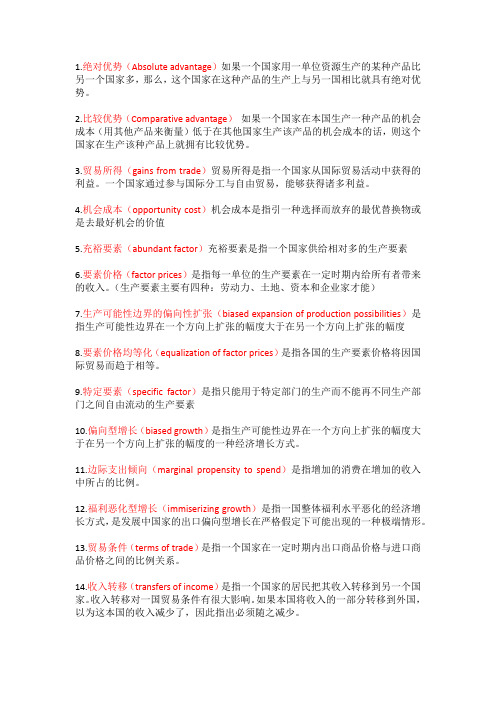
1.绝对优势(Absolute advantage)如果一个国家用一单位资源生产的某种产品比另一个国家多,那么,这个国家在这种产品的生产上与另一国相比就具有绝对优势。
2.比较优势(Comparative advantage)如果一个国家在本国生产一种产品的机会成本(用其他产品来衡量)低于在其他国家生产该产品的机会成本的话,则这个国家在生产该种产品上就拥有比较优势。
3.贸易所得(gains from trade)贸易所得是指一个国家从国际贸易活动中获得的利益。
一个国家通过参与国际分工与自由贸易,能够获得诸多利益。
4.机会成本(opportunity cost)机会成本是指引一种选择而放弃的最优替换物或是去最好机会的价值5.充裕要素(abundant factor)充裕要素是指一个国家供给相对多的生产要素6.要素价格(factor prices)是指每一单位的生产要素在一定时期内给所有者带来的收入。
(生产要素主要有四种:劳动力、土地、资本和企业家才能)7.生产可能性边界的偏向性扩张(biased expansion of production possibilities)是指生产可能性边界在一个方向上扩张的幅度大于在另一个方向上扩张的幅度8.要素价格均等化(equalization of factor prices)是指各国的生产要素价格将因国际贸易而趋于相等。
9.特定要素(specific factor)是指只能用于特定部门的生产而不能再不同生产部门之间自由流动的生产要素10.偏向型增长(biased growth)是指生产可能性边界在一个方向上扩张的幅度大于在另一个方向上扩张的幅度的一种经济增长方式。
11.边际支出倾向(marginal propensity to spend)是指增加的消费在增加的收入中所占的比例。
12.福利恶化型增长(immiserizing growth)是指一国整体福利水平恶化的经济增长方式,是发展中国家的出口偏向型增长在严格假定下可能出现的一种极端情形。
国际经济学名词解释双语(2)
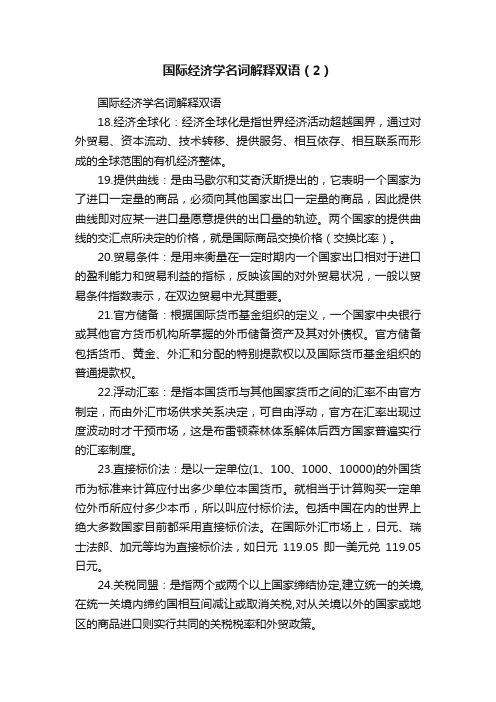
国际经济学名词解释双语(2)国际经济学名词解释双语18.经济全球化:经济全球化是指世界经济活动超越国界,通过对外贸易、资本流动、技术转移、提供服务、相互依存、相互联系而形成的全球范围的有机经济整体。
19.提供曲线:是由马歇尔和艾奇沃斯提出的,它表明一个国家为了进口一定量的商品,必须向其他国家出口一定量的商品,因此提供曲线即对应某一进口量愿意提供的出口量的轨迹。
两个国家的提供曲线的交汇点所决定的价格,就是国际商品交换价格(交换比率)。
20.贸易条件:是用来衡量在一定时期内一个国家出口相对于进口的盈利能力和贸易利益的指标,反映该国的对外贸易状况,一般以贸易条件指数表示,在双边贸易中尤其重要。
21.官方储备:根据国际货币基金组织的定义,一个国家中央银行或其他官方货币机构所掌握的外币储备资产及其对外债权。
官方储备包括货币、黄金、外汇和分配的特别提款权以及国际货币基金组织的普通提款权。
22.浮动汇率:是指本国货币与其他国家货币之间的汇率不由官方制定,而由外汇市场供求关系决定,可自由浮动,官方在汇率出现过度波动时才干预市场,这是布雷顿森林体系解体后西方国家普遍实行的汇率制度。
23.直接标价法:是以一定单位(1、100、1000、10000)的外国货币为标准来计算应付出多少单位本国货币。
就相当于计算购买一定单位外币所应付多少本币,所以叫应付标价法。
包括中国在内的世界上绝大多数国家目前都采用直接标价法。
在国际外汇市场上,日元、瑞士法郎、加元等均为直接标价法,如日元119.05即一美元兑119.05日元。
24.关税同盟:是指两个或两个以上国家缔结协定,建立统一的关境,在统一关境内缔约国相互间减让或取消关税,对从关境以外的国家或地区的商品进口则实行共同的关税税率和外贸政策。
25.升水与贴水:远期汇率与即期汇率的差额用升水、贴水和平价来表示。
升水意味着远期汇率比即期的要高,贴水则反之。
一般情况下,利息率较高的货币远期汇率大多呈贴水,利息率较低的货币远期汇率大多呈升水。
国际经济学中英名词解释
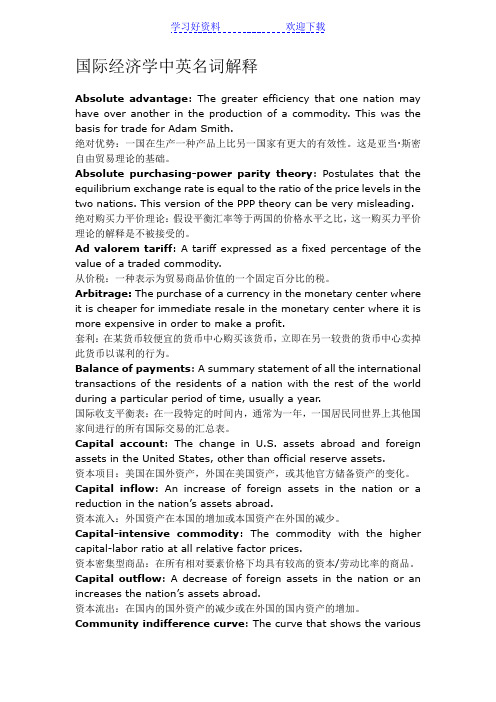
国际经济学中英名词解释Absolute advantage: The greater efficiency that one nation may have over another in the production of a commodity. This was the basis for trade for Adam Smith.绝对优势:一国在生产一种产品上比另一国家有更大的有效性。
这是亚当·斯密自由贸易理论的基础。
Absolute purchasing-power parity theory: Postulates that the equilibrium exchange rate is equal to the ratio of the price levels in the two nations. This version of the PPP theory can be very misleading. 绝对购买力平价理论:假设平衡汇率等于两国的价格水平之比,这一购买力平价理论的解释是不被接受的。
Ad valorem tariff: A tariff expressed as a fixed percentage of the value of a traded commodity.从价税:一种表示为贸易商品价值的一个固定百分比的税。
Arbitrage: The purchase of a currency in the monetary center where it is cheaper for immediate resale in the monetary center where it is more expensive in order to make a profit.套利:在某货币较便宜的货币中心购买该货币,立即在另一较贵的货币中心卖掉此货币以谋利的行为。
国际经济学名词解释 英文版
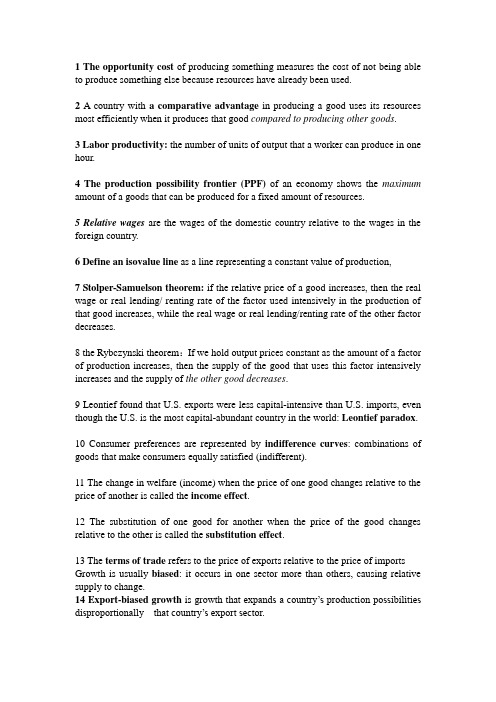
1 The opportunity cost of producing something measures the cost of not being able to produce something else because resources have already been used.2 A country with a comparative advantage in producing a good uses its resources most efficiently when it produces that good compared to producing other goods.3 Labor productivity: the number of units of output that a worker can produce in one hour.4 The production possibility frontier (PPF) of an economy shows the maximum amount of a goods that can be produced for a fixed amount of resources.5 Relative wages are the wages of the domestic country relative to the wages in the foreign country.6 Define an isovalue line as a line representing a constant value of production,7 Stolper-Samuelson theorem: if the relative price of a good increases, then the real wage or real lending/ renting rate of the factor used intensively in the production of that good increases, while the real wage or real lending/renting rate of the other factor decreases.8 the Rybczynski theorem:If we hold output prices constant as the amount of a factor of production increases, then the supply of the good that uses this factor intensively increases and the supply of the other good decreases.9 Leontief found that U.S. exports were less capital-intensive than U.S. imports, even though the U.S. is the most capital-abundant country in the world: Leontief paradox.10 Consumer preferences are represented by indifference curves: combinations of goods that make consumers equally satisfied (indifferent).11 The change in welfare (income) when the price of one good changes relative to the price of another is called the income effect.12 The substitution of one good for another when the price of the good changes relative to the other is called the substitution effect.13 The terms of trade refers to the price of exports relative to the price of imports Growth is usually biased: it occurs in one sector more than others, causing relative supply to change.14 Export-biased growth is growth tha t expands a country’s production possibilities disproportionally that country’s export sector.15 Import-biased growth is growth that expands a country’s production possibilities disproportionally in that country’s import sector16Immiserizing growth:export-biased growth by poor nations would worsen their terms of trade so much that they would be worse off than if they had not grown at all.16 Import tariffs are taxes levied on imports17 Export subsidies are payments given to domestic producers that export.18 External economies of scale occur when cost per unit of output depends on thesize of the industry19 Internal economies of scale occur when the cost per unit of output depends on the size of a firm.20 A monopoly is an industry with only one firm.21 An oligopoly is an industry with only a few firms.22 Average cost is the cost of production (C) divided by the total quantity ofproduction (Q). AC = C/Q23 Marginal cost is the cost of producing an additional unit of output.24 Monopolistic competition is a model of an imperfectly competitive industrywhich assumes thatA:Each firm can differentiate its product from the product of competitors.B:Each firm ignores the impact that changes in its price will have on the prices that competitors set: even though each firm faces competition it behaves as if it were a monopolist.25 Suppose now that the global cloth industry is described by the monopolisticcompetition model.Because of product differentiation, suppose that each country produces different types of cloth.Because of economies of scale, large markets are desirable: the foreign country exports some cloth and the domestic country exports some cloth.Trade occurs within the cloth industry: intra-industry trade26 According to the Heckscher-Ohlin model or Ricardian model, countries specializein production.Trade occurs only between industries: inter-industry tradeIn a Heckscher-Ohlin model suppose that:The capital abundant domestic economy specializes in the production of capitalintensive cloth, which is imported by the foreign economy.The labor abundant foreign economy specializes in the production of labor intensive food, which is imported by the domestic economy.27 Dumping is the practice of charging a lower price for exported goods than forgoods sold domestically28 Dumping is an example of price discrimination: the practice of charging different customers different prices29 Specialized equipment or services may be needed for the industry, but are only supplied by other firms if the industry is large and concentrated30 Labor pooling: a large and concentrated industry may attract a pool of workers,reducing employee search and hiring costs for each firm.31 Knowledge spillovers: workers from different firms may more easily share ideasthat benefit each firm when a large and concentrated industry exists32 Dynamic increasing returns to scale exist if average costs fall as cumulativeoutput over time rises.33 economic geography refers to the study of international trade, interregional tradeand the organization of economic activity in metropolitan and rural areas34 A specific tariff is levied as a fixed charge for each unit of imported goods35 An ad valorem tariff is levied as a fraction of the value of imported goods36 The effective rate of protection measures how much protection a tariff or othertrade policy provides domestic producers37 Consumer surplus measures the amount that consumers gain from purchases bythe difference in the price that each pays from the maximum price each would be willing to pay38 Producer surplus measures the amount that producers gain from a sale by thedifference in the price each receives from the minimum price each would be willing to sell at39 An export subsidy can also be specific or ad valorem:A specific subsidy is a payment per unit exported. An ad valorem subsidy is a payment as a proportion of the value exported.40 An import quota is a restriction on the quantity of a good that may be imported. 41A voluntary export restraint works like an import quota, except that the quota is imposed by the exporting country rather than the importing country.42 A local content requirement is a regulation that requires a specified fraction of a final good to be produced domestically43Gross national product(GNP) is the value of all final goods and services produced by a nation’s factors of production in a giventime period44 Gross domestic product measures the final value of all goods and services that are produced within a country in a given time period45National income is often defined to be the income earned by a nation’s factors of production.46 Depreciation of physical capital results in a loss of income to capital owners, so the amount of depreciation is subtracted from GNP47 Unilateral transfers to and from other countries can change national income: payments of expatriate workers sent to their home countries, foreign aid and pension payments sent to expatriate retirees48current account: accounts for flows of goods and services (imports and exports). financial account: accounts for flows of financial assets (financial capital). capital account: flows of special categories of assets (capital): typicallynon-market, non-produced, or intangible assets like debtforgiveness, copyrights and trademarks49 Appreciation is an increase in the value of a currency relative to another currency. Depreciation is a decrease in the value of a currency relative to another currency 50 Arbitrage: buying at a low price and selling at a high price for a profit.51Spot rates are exchange rates for currency exchanges “on the spot”, or when trading is executed in the present52Forward rates are exchange rates for currency exchanges that will occur at a future (“forward”) date.53 Money demand represents the amount of monetary assets that people are willing to hold (instead of illiquid assets).54The central bank substantially controls the quantity of money that circulates in an economy, the money supply55Interest rates/expected rates of return on monetary assets relative to the expected rates of returns on non-monetary assets.56 Risk: the risk of holding monetary assets principally comes from unexpectedinflation, which reduces the purchasing power of money.57 Liquidity: A need for greater liquidity occurs when the price of transactionsincreases or the quantity of goods bought in transactions increases.58 Prices: the prices of goods and services bought in transactions will influence the willingness to hold money to conduct those transactions59 Income: greater income implies more goods and services can be bought, so thatmore money is needed to conduct transactions60 (DF –QF) = (PC /PF)(QC –DC)❖This equation is the budget constraint for an economy, and it has a slope of –(PC /PF)(DF –QF)–(PC /PF)(QC –DC) = 0❖Note that the budget constraint touches the PPF: a country can always afford to consume what it produces.❖However, a country need not consumeonly the goods and services that it produceswith trade.Exports and imports can be greater than zero.❖Furthermore, a country can afford to consume more of both goods with trade.。
国际经济学名词解释双语(3)
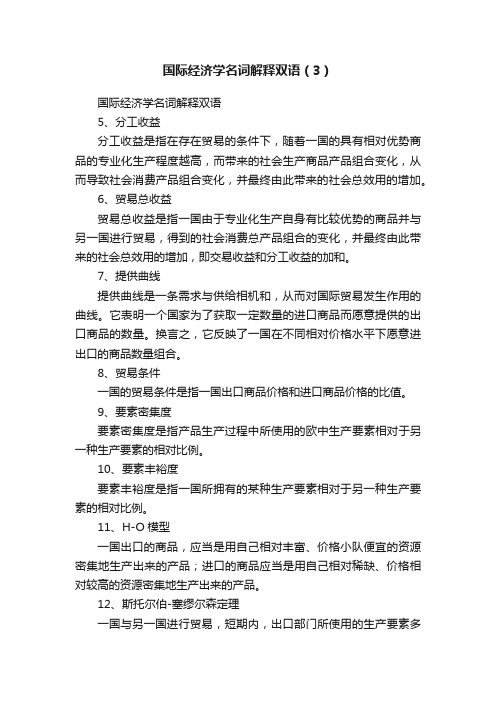
国际经济学名词解释双语(3)国际经济学名词解释双语5、分工收益分工收益是指在存在贸易的条件下,随着一国的具有相对优势商品的专业化生产程度越高,而带来的社会生产商品产品组合变化,从而导致社会消费产品组合变化,并最终由此带来的社会总效用的增加。
6、贸易总收益贸易总收益是指一国由于专业化生产自身有比较优势的商品并与另一国进行贸易,得到的社会消费总产品组合的变化,并最终由此带来的社会总效用的增加,即交易收益和分工收益的加和。
7、提供曲线提供曲线是一条需求与供给相机和,从而对国际贸易发生作用的曲线。
它表明一个国家为了获取一定数量的进口商品而愿意提供的出口商品的数量。
换言之,它反映了一国在不同相对价格水平下愿意进出口的商品数量组合。
8、贸易条件一国的贸易条件是指一国出口商品价格和进口商品价格的比值。
9、要素密集度要素密集度是指产品生产过程中所使用的欧中生产要素相对于另一种生产要素的相对比例。
10、要素丰裕度要素丰裕度是指一国所拥有的某种生产要素相对于另一种生产要素的相对比例。
11、H-O模型一国出口的商品,应当是用自己相对丰富、价格小队便宜的资源密集地生产出来的产品;进口的商品应当是用自己相对稀缺、价格相对较高的资源密集地生产出来的产品。
12、斯托尔伯-塞缪尔森定理一国与另一国进行贸易,短期内,出口部门所使用的生产要素多获得利益,要素价格上升,而进口部门所使用的生产要素都遭受损失,要素价格下降;长期中,则是在出口产品生产中密集使用的要素获利,而那些在进口产品中密集使用的要素受损。
13、要素价格均等化定理在严格假设的条件下,国际贸易会使各国通知要素获得相同的相对收入和绝对收入。
14、里昂惕夫之谜美国经济学家里昂惕夫利用1947年美国的投入—产出表,测算了美国进出口商品的要素含量。
在测算之前,他推断与世界其他国家相比,美国应是资本丰富的国家,但结果却证明了美国出口劳动密集型商品,进口资本密集型商品,这一结果与H-0理论相反,故称之为里昂惕夫之谜或里昂惕夫悖论。
国际经济学英文版名词解释 附有中文解释

1 Absolute advantage:绝对优势 The greater efficiency that one nation may have over another in the production of a commodity.This was the basis for trade for Adam Smith.2 Ad valorem tariff: 从价税 A tariff expressed as a fixed percentage of the value of a traded commodity.3 Balance of payments: 收支平衡 A summary statement of all the international transactions of the residents of a nation with the rest of the world during a particular period of time,usually a year.4 Balanced growth: 均衡增长 Equal rates of factor growth and technological progress in the production of both commodities.5 Buffer stocks: 缓冲存货The type of international commodity agreement that involves the purchase of the commodity(to be added to the stock)when the commodity price falls below an agreed minimum price,and the sale of the commodity out of the stock when the commodity price rises above the established maximum price.6 Constant opportunity costs:机会成本不变The constant amount of a commodity that must be given up to produce each additional unit of another commodity.7 Community indifference curve:社会无差异曲线The curve that shows the various combinations of two commodity yielding equal satisfaction to the community or munity indifference curves are negatively sloped,convex from the origin,and should not cross.8 Compound tariff:混合关税A combination of an ad valorem and a specific tariff.9 Customs union:关税同盟Removes all barriers on trade among members and harmonizes trade policies toward the rest of the world.The best example is the European Union(EU).10 Common market:共同市场 Removes all barriers on trade amongmembers,harmonizes trade policies toward the rest of the world,and also allows the free movement of labor and capital among member nations.An example is the European Union(EU)since January 1,1993.11 Dumping: 倾销The export of a commodity at below cost or at a lower price than sold domestically.12 Direct investments:直接投资 Real investments in factories,capital goods,land,and inventories where both capital and management are involved and the investor retains control over the use of the invested capital.13 Free trade area:自由贸易区 Removes all barriers on trade among members,but each nation restains its own barriers on trade with nonmembers.The best example are the EFTA,NAFTA,and Mercosur.14 Factor-price equalization(H-O) theorem:要素禀赋(赫克歇尔—俄林)理论The part of the H-O theory that predicts,under highly restrictive assumptions,that international trade will bring about equalization in relative and absolute returns to homogeneous factors across nations.15 Heckscher-Ohlin(H-O) theory:赫克歇尔—俄林理论The theory that postulates that(1)a nation exports commodities intensive in its relatively abundant and cheap factor and(2)international trade brings about equalization in returns to homogeneous factors across countries.16 Interdependence:相互依赖The (economic) relationships among nation.17 Increasing opportunity costs:机会成本递增The increasing amounts of one commodity that a nation must give up to release just enough resources to produce each additional unit of another commodity.This is reflected in a production frontier that is concave from the origin.18 International cartel: 国际卡特尔An organization of suppliers of a commodity located in different nations(or a group of governments) that agrees to restrict output and exports of the commodity with the aim of maximizing or increasing the total profits of the organization.An international cartel that behaves as a monopolist is called a centralized cartel.19 Income terms of trade:收入贸易条件The ratio of the price index of the nation’s exports to the price index of its imports times the index of the nation’s volume of exports.20 Immiserizing growth:悲惨性增长The situation where a nation’s terms of trade deteriorate so much as a result of growth that the nation is worse off after growth than before,even if growth without trade tends to improve the nation’s welfare.21 Leontief paradox:里昂惕夫之谜The empirical finding that U.S import substitutes were more K intensive than U.S exports.This is contrary to the H-Otrade model,which predicts that,as the most K-abundant nation,the United States should import L-intensive products and export K-intensive products.22 Marginal rate of transformation(MRT):边际转换率The amount of one commodity that a nation must give up to produce each additional unit of another commodity.This is another name for the opportunity cost of a commodity and is given by the slope of the production frontier at the point of production.23 Marginal rate of substitution(MRS):边际替代率The amount of one commodity that a nation could give up in exchange for one extra unit of second commodity and still remain on the same indifference curve.It is given by the slope of the community indifference curve at the point of consumption and declines as the nation consumes more of the second commodity.24 Multinational corporations(MNCs):跨国公司Firms that own,control,or manage production and distribution facilities in several countries.25 Optimum tariff:适稅The rate of tariff that maximizes the benefit resulting from improvement in the nation's terms of trade against the negative effect resulting from reduction in the volume of trade.26 Pattern of trade:贸易格局The commodities exported and imported by each nation.27 Production possibility frontier:生产可能性曲线 A curve showing the various alternative combinations of two commodities that a nation can produce by fully utilizing all of its resources with the best technology available to it.28 Prohibitive tariff:禁止性关税A tariff sufficiently high to stop all international trade so that the nation returns to autarky.29 Persistent dumping:连续性倾销The continuous tendency of a domestic monopolist to maximize total profits by selling the commodity at a lower price abroad than domestically;also called international price discriminztion.30 Predatory dumping:掠夺性倾销The temporary sale of commodity at a lower price abroad in order to drive foreign producers out of business,after which prices are raised to take advantage of the newly acquired monopoly power abroad.31 Preferential trade arrangements:优惠贸易安排The loosest from of economic integration;provides lower barriers to trade among participatingnations than on trade with nonparticipating nations.An example is the British Commonwealth Preference Scheme.32 Purchase contracts:.购货契约Long-term multilateral agreements that stipulate the minimum price at which importing nations agree to purchase a specified quantity of the commodity and a maximum price at which exporting nations agree to sell specified amounts of the commodity.33 Portfolio investments:投资组合The purchase of purely financial assets,such as bonds and stocks(if the stock purchase represents less than 10 percent of the stock of a corporation),usu34 Stolper-Samuelson theorem:施托尔珀-萨缪尔森定理It postulates that free international trade reduces the real income of the nation's relatively scarce factor and increases the real income of the nation's relatively abundant factor.35 Specific tariff: 从量税 A tariff expressed as a fixed sum per unit of a traded commodity.36 Sporadic dumping:偶尔倾销The occasional sale of a commodity at a lower price abroad than domestically in order to sell an unforeseen and temporary surplus of the commodity abroad without having to reduce domestic prices.37 Terms of trade:贸易条件The ratio of the index price of a nation's export to its import commodities.38 Trade creation:贸易创造 Occurs when some domestic production in a member of the customs union is replaced by lower-cost imports from another member nation.This increases welfare.39 Trade diversion:贸易转移 Occurs when lowercost imports from outside the union are replaced by higher-cost imports from another union member.By itself,this reduces welfare.40 Transfer pricing:转移价格The overpricing or underpricing of products in the intrafirm trade of multinational corporations in an attempt to shift income and profits from high-to low-tax nations.。
成都理工大学国际经济学重点英文名词解释(精选5篇)
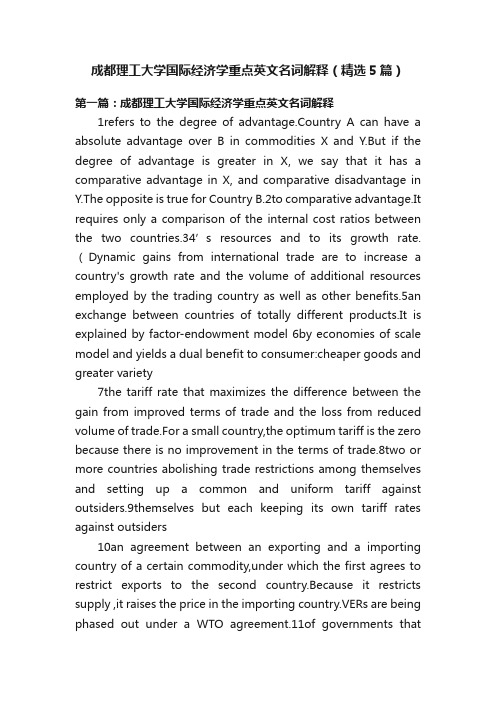
成都理工大学国际经济学重点英文名词解释(精选5篇)第一篇:成都理工大学国际经济学重点英文名词解释1refers to the degree of advantage.Country A can have a absolute advantage over B in commodities X and Y.But if the degree of advantage is greater in X, we say that it has a comparative advantage in X, and comparative disadvantage in Y.The opposite is true for Country B.2to comparative advantage.It requires only a comparison of the internal cost ratios between the two countries.34’s resou rces and to its growth rate.(Dynamic gains from international trade are to increase a country's growth rate and the volume of additional resources employed by the trading country as well as other benefits.5an exchange between countries of totally different products.It is explained by factor-endowment model 6by economies of scale model and yields a dual benefit to consumer:cheaper goods and greater variety7the tariff rate that maximizes the difference between the gain from improved terms of trade and the loss from reduced volume of trade.For a small country,the optimum tariff is the zero because there is no improvement in the terms of trade.8two or more countries abolishing trade restrictions among themselves and setting up a common and uniform tariff against outsiders.9themselves but each keeping its own tariff rates against outsiders10an agreement between an exporting and a importing country of a certain commodity,under which the first agrees to restrict exports to the second country.Because it restricts supply ,it raises the price in the importing country.VERs are being phased out under a WTO agreement.11of governments thatagree to restrict trade in a commodity.It includes only suppliers.1213the sale of a commodity abroad at a price lower than what it fetches in the home country.Often it is a result of a monopolist discriminating between the domestic and foreign markets.14product that it exports.15feature of “globalization” is the ever increasing flow of private capital between countries,especially in the form of direct foreign investment.16:is favorable to world welfare because it rationally reorganizes production within the union.1718“specialization” and “reallocation of existing resources”第二篇:宏观经济学重点名词解释51、过剩生产能力(Excess capacity)过剩生产能力是指成本最低产量与长期均衡中的实际产量之差。
国际经济学名词解释
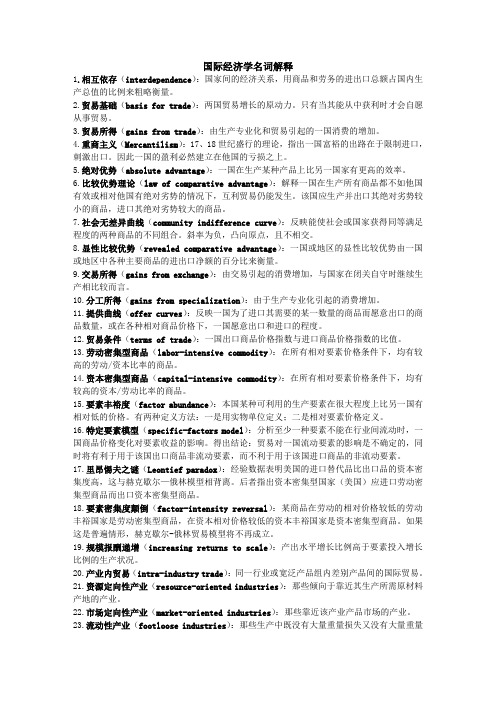
国际经济学名词解释1.相互依存(interdependence):国家间的经济关系,用商品和劳务的进出口总额占国内生产总值的比例来粗略衡量。
2.贸易基础(basis for trade):两国贸易增长的原动力。
只有当其能从中获利时才会自愿从事贸易。
3.贸易所得(gains from trade):由生产专业化和贸易引起的一国消费的增加。
4.重商主义(Mercantilism):17、18世纪盛行的理论,指出一国富裕的出路在于限制进口,刺激出口。
因此一国的盈利必然建立在他国的亏损之上。
5.绝对优势(absolute advantage):一国在生产某种产品上比另一国家有更高的效率。
6.比较优势理论(law of comparative advantage):解释一国在生产所有商品都不如他国有效或相对他国有绝对劣势的情况下,互利贸易仍能发生。
该国应生产并出口其绝对劣势较小的商品,进口其绝对劣势较大的商品。
7.社会无差异曲线(community indifference curve):反映能使社会或国家获得同等满足程度的两种商品的不同组合。
斜率为负,凸向原点,且不相交。
8.显性比较优势(revealed comparative advantage):一国或地区的显性比较优势由一国或地区中各种主要商品的进出口净额的百分比来衡量。
9.交易所得(gains from exchange):由交易引起的消费增加,与国家在闭关自守时继续生产相比较而言。
10.分工所得(gains from specialization):由于生产专业化引起的消费增加。
11.提供曲线(offer curves):反映一国为了进口其需要的某一数量的商品而愿意出口的商品数量,或在各种相对商品价格下,一国愿意出口和进口的程度。
12.贸易条件(terms of trade):一国出口商品价格指数与进口商品价格指数的比值。
13.劳动密集型商品(labor-intensive commodity):在所有相对要素价格条件下,均有较高的劳动/资本比率的商品。
《国际经济学》名词解释(第二篇)
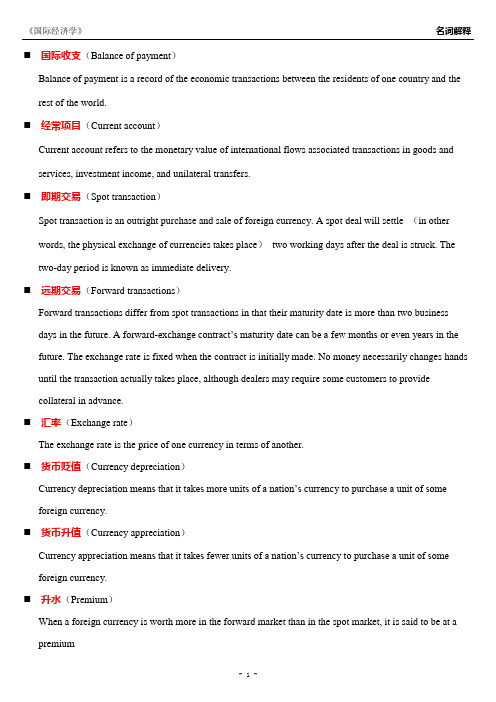
⏹国际收支(Balance of payment)Balance of payment is a record of the economic transactions between the residents of one country and the rest of the world.⏹经常项目(Current account)Current account refers to the monetary value of international flows associated transactions in goods and services, investment income, and unilateral transfers.⏹即期交易(Spot transaction)Spot transaction is an outright purchase and sale of foreign currency. A spot deal will settle (in other words, the physical exchange of currencies takes place)two working days after the deal is struck. The two-day period is known as immediate delivery.⏹远期交易(Forward transactions)Forward transactions differ from spot transactions in that their maturity date is more than two business days in the future. A forward-exchange contract’s maturity date can be a few months or even years in the future. The exchange rate is fixed when the contract is initially made. No money necessarily changes hands until the transaction actually takes place, although dealers may require some customers to providecollateral in advance.⏹汇率(Exchange rate)The exchange rate is the price of one currency in terms of another.⏹货币贬值(Currency depreciation)Currency depreciation means that it takes more units of a nation’s currency to purchase a unit of some foreign currency.⏹货币升值(Currency appreciation)Currency appreciation means that it takes fewer units of a nation’s currency to purchase a unit of some foreign currency.⏹升水(Premium)When a foreign currency is worth more in the forward market than in the spot market, it is said to be at a premium⏹贴水(Discount)When a foreign currency is worth less in the forward market than in the spot market, it is said to be at a discount⏹套汇(Exchange arbitrage)Exchange arbitrage refers to the simultaneous purchase and sale of a currency in differentforeign-exchange markets in order to profit from exchange-rate differentials in the two locations. This process brings about an identical price for the same currency in different locations and thus results in one market.⏹一价定律(Law of one price)Law of one price asserts that identical goods should cost the same in all nations, assuming that it is costless to ship goods between nations and there are no barriers to trade.⏹相对购买力平价(Relative purchasing power parity )According to the relative purchasing power parity, changes in relative national price levels determine changes in exchange rates over the long run. The theory predicts that the foreign-exchange value of a currency tends to appreciate or depreciate at a rate equal to the difference between foreign and domestic inflation.⏹汇率超调(Exchange-rate overshooting)An exchange rate is said to overshoot when its short-run response to a change in market fundamentals is greater than its long-run response.⏹套利(Interest arbitrage)Interest arbitrage refers to the process of moving funds into foreign currencies to take advantage of higher investment yields abroad.⏹无抛补套利(Uncovered interest arbitrage)Uncovered interest arbitrage occurs when an investor does not obtain exchange market cover to protect investment proceeds from foreign-currency fluctuations.⏹抛补套利(Covered interest arbitrage)Covered interest arbitrage involves two basic steps. First, an investor exchanges domestic currency for foreign currency, at the current spot rate, and uses the foreign currency to finance a foreign investment. At the same time, the investor contracts in the forward market to sell the amount of the foreign currency that will be received as the proceeds from the investment, with a delivery date to coincide with the maturity ofthe investment. It pays for the investor to make the foreign investment if the positive interest ratedifferential in favour of the foreign investment more than offsets the cost of obtaining the forward cover.⏹马歇尔---勒纳条件(Marshall-Lerner Condition)Devaluation will improve the trade balance if domestic demand elasticity for imports plus foreign demand.Devaluation will worsen the trade balance if the sum of the two elasticities is less than 1. If the sum is equal to 1, devaluation will have no effect⏹J曲线效应(The J-curve effect)In the very shor t run, currency devaluation will lead to a worsening of a nation’s trade balance. But as time passes, the trade balance will likely improve.⏹货币传递效应(The passing-through effect)The extent to which changing currency values lead to changes in import and export prices is known as the currency passing-through relationship.。
国际经济学 名词解释 Robert J. Carbaugh
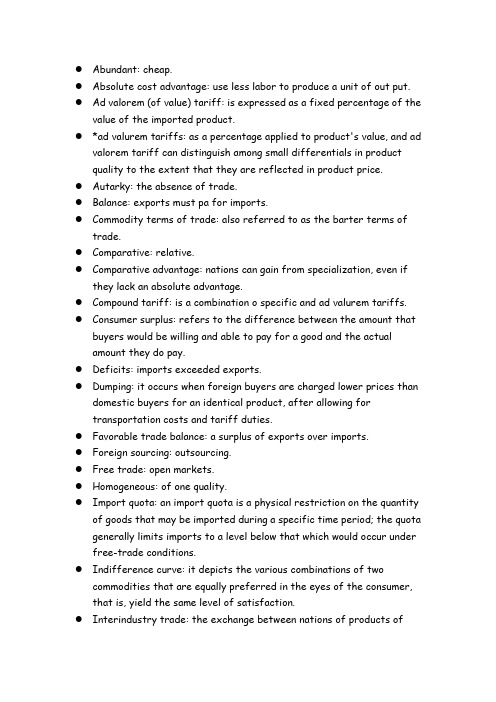
●Abundant: cheap.●Absolute cost advantage: use less labor to produce a unit of out put.●Ad valorem (of value) tariff: is expressed as a fixed percentage of thevalue of the imported product.●*ad valurem tariffs: as a percentage applied to product's value, and advalorem tariff can distinguish among small differentials in productquality to the extent that they are reflected in product price.●Autarky: the absence of trade.●Balance: exports must pa for imports.●Commodity terms of trade: also referred to as the barter terms oftrade.●Comparative: relative.●Comparative advantage: nations can gain from specialization, even ifthey lack an absolute advantage.●Compound tariff: is a combination o specific and ad valurem tariffs.●Consumer surplus: refers to the difference between the amount thatbuyers would be willing and able to pay for a good and the actualamount they do pay.●Deficits: imports exceeded exports.●Dumping: it occurs when foreign buyers are charged lower prices thandomestic buyers for an identical product, after allowing fortransportation costs and tariff duties.●Favorable trade balance: a surplus of exports over imports.●Foreign sourcing: outsourcing.●Free trade: open markets.●Homogeneous: of one quality.●Import quota: an import quota is a physical restriction on the quantityof goods that may be imported during a specific time period; the quota generally limits imports to a level below that which would occur under free-trade conditions.●Indifference curve: it depicts the various combinations of twocommodities that are equally preferred in the eyes of the consumer, that is, yield the same level of satisfaction.●Interindustry trade: the exchange between nations of products ofdifferent industries.●Interindustry specialization: each nation specializes in a particularindustry in which it enjoys a comparative advantage.●Intraindustry trade: two-way trade in a similar commodity.●Offshore-assembly provision (OAP): provides favorable treatment toproducts assembled abroad from U.S.-manufactured components.●Predatory dumping: it occurs when a producer temporarily reduces theprices charged abroad to drive foreign competitors out of business.●Primary products: agricultural goods, raw materials, and fuels.●Producer surplus: producer surplus is the revenue producers receiveover and above the minimum amount required to induce them to supply the good.●Productivity: output per worker hour.●Production possibilities schedule: this schedule shows variousalternative combinations of two goods that a nation can produce when all of its factor inputs are used in their most efficient manner.●Protective effect: it illustrates the loss to the domestic economyresulting from wasted resources used to produce additional autos at increasing unit costs.●Protective tariff: is designed to insulate import-competing producersfrom foreign competition.●Redistributive effect: redistributive effect is the transfer ofcomsumer surplus, in monetary terms, to the domestic producers of the import-competing product.●Resource endowments: such as labor and capital.●Revenue effect: revenue effect presents the government's collectionsof duty.●Revenue tariff: is imposed for the purpose of generating tax revenuesand may be placed on either exports or imports.●Scarce: expensive.●Specific tariff: is expressed in terms of a fixed amount of money perphysical unit of the imported product.●*specific tariff: as a fixed monetary duty per unit of the importedproduct, a specific tariff is relatively easy to apply and administer,particularly to standardized commodities and staple products where the value of the dutiable goods cannot be easily observed.●Sporadic dumping(distress dumping): it occurs when a firm disposes ofexcess inventories on foreign markets by selling abroad at lower prices than at home.●Supply schedule: the law of supply indicates that a producer's supplyprice rises as the producer offers more of the good for sale on the market.●Tariff: is simply a tax (duty) levied on a product when it crossesnational boundaries.●Theory of reciprocal demand: this theory suggests that the actualprice at which trade takes place depends on the trading partners'interacting demands.●The marginal rate of transformation(MRT): the MRT show the amountof one product a nation must sacrifice to get one additional unit of the other product.●The principle of absolute advantage: in a two-nation, two-product world,international trade ad specialization will be beneficial when one nation has an absolute cost advantage in one good and the other nation has an absolute cost advantage in the other good.●The terms of trade: the set of posttrade consumption points that anation can achieve is determined by the rate at which its exportproducts traded for the other country's export product.●Trade triangle: the triangle shows the exports, imports, and terms oftrade.●Trading possibilities line: note that it is drawn with a slope having anabsolute value of 1.●The marginal rate of substitution(MRS): the rate of substituting onegood for another is shown by the slope of the curve.。
- 1、下载文档前请自行甄别文档内容的完整性,平台不提供额外的编辑、内容补充、找答案等附加服务。
- 2、"仅部分预览"的文档,不可在线预览部分如存在完整性等问题,可反馈申请退款(可完整预览的文档不适用该条件!)。
- 3、如文档侵犯您的权益,请联系客服反馈,我们会尽快为您处理(人工客服工作时间:9:00-18:30)。
1. 国际经济学:以经济学的一般理论为基础,研究国际经济活动和国际经济关系,是一般经济理论在国际经济活动范围中的应用与延伸,是经济学体系的有机组成部分。
主要研究对象有国际贸易理论与政策、国际收支理论、汇率理论、要素的国际流动、国际投资理论、开放的宏观经济均衡等。
2. 绝对利益:由英国古典经济学家亚当·斯密提出,是指在某种商品的生产上,一个经济在劳动生产率上占有绝对优势,或其生产所耗费的劳动成本绝对低于另一个经济。
若各个经济都从事自己占绝对优势的产品的生产,继而进行交换,那么双方都可以通过交换得到绝对的利益,从而整个世界也可以获得分工的好处。
3. 比较利益:英国古典经济学家大卫·李嘉图认为,决定国际贸易的基础是比较利益而非绝对利益。
国际分工中若两个贸易参与国家生产力水平不相等,甲国在生产任何产品时成本均低于乙国,处于绝对优势;而乙国则相反,其劳动生产率在任何产品上均低于甲国,处于绝对劣势。
4. 国际分工:即各国之间的劳动分工,生产的国际专业化,它是经济发展的必然,是社会分工从一国国内向国外延伸的结果。
各国对于分工方式的选择以及分工的变化,反映了彼此之间的经济发展水平的差异以及各国经济联系的程度。
国际分工主要有产业间、产业内、垂直、水平以及不同要素密集度之间的分工等类型。
5. 贸易乘数:是指乘数理论在对外贸易研究中的运用,探讨对外贸易与国民收入与就业之间的关系。
在贸易乘数公式中,它是边际储蓄倾向的和的倒数。
贸易乘数原理主要分析在边际储蓄倾向和边际进口倾向之和小于1的条件下,增加出口有利于提高有效需求,增加国民收入和就业量。
6. 贸易创造:是指在关税同盟内部取消成员国之间的关税后,国内生产成本高的商品被成员国中生产成本低的商品所取代,来自成员国的低价进口商品替代了昂贵的国内生产的商品,成员国之间的贸易被创造出来。
7. 贸易转移:两个或两个以上国家间的关税同盟建立后,成员国的部分进口商品将从低成本供应国(非成员国)转向高成本供应国(成员国),这就是贸易转移。
这对进口国是种福利损失。
8. 流动借贷:流动借贷是指国际借贷中形成了借贷关系并且进入了实际支付的那种债权、债务关系,是决定汇率变动的因素。
它对国际收支的平衡从而对汇率的走向有着重要的决定性影响。
9. 固定借贷:是指国际借贷中形成了借贷关系,但尚未进入实际支付的那种债权、债务关系,对国际收支从而对汇率的走向没有实质的决定性作用,有时甚至会产生相反的汇率表现(固定借贷的发生有时会促使本币汇率上升),即债务存在时汇率反而走高。
10.国际收支:国际货币基金组织对国际收支的定义为:国际收支是一种统计报表,系统的记载了在一定时期内经济主体与世界其他地方的交易。
大部分交易在居民与非居民之间进行。
11.边际进口倾向:是指每一单位增量国民收入中,用于进行进口的比重,通常中公式中用m来表示。
边际进口倾向大,则每一单位增量国民收入中用于进口的比重大,乘数效应对于经济的刺激作用就会较小,反之则较大。
12.外汇倾销:利用本国货币对外贬值的机会,向外倾销商品和争夺市场的行为称为外汇倾销。
这是因为本国货币贬值后,出口商品用外国货币表示价格降低,提高了该国商品在国际市场上的竞争力,有利于扩大出口;而因本国货币贬值,进口商品的价格上涨,削弱了进口商品的竞争力,限制了进口。
外汇倾销需要一定的条件,主要是本国货币对外贬值速度要快于对内贬值以及对方不进行报复等。
13.幼稚产业:是指某一产业处于发展初期,基础和竞争力薄弱但经过适度保护能够发展成为具有潜在比较优势的新兴产业。
在保护幼稚产业上,如何界定和选择幼稚产业是一个关键,选择不好就可能导致保护落后,保护需要大量的投入,付出一定的代价。
14.外汇汇率:
15.开放经济:指一国与国外有着经济往来,如存在国际贸易、国际金融往来,也就是对外有进出口和货币、资本的往来,本国经济与外国经济之间存在着密切的关系,即为开放经济。
16.倾销:是指在正常贸易过程中进口产品以低于其正常价值的出口价格进入市场。
对倾销的调查和确定,由对外贸易经济合作部(以下简称外经贸部)负责。
17.关税壁垒与非关税壁垒:关税壁垒是指高额进口税。
通过征收各种高额进口税,形成对外国商品进入本国市场的阻碍,这可以提高进口商品的成本从而削弱其竞争能力,起到保护国内生产和国内市场的作用。
它还是在贸易谈判中迫使对方妥协让步的重要手段。
世界贸易组织对其极力反对,并通过谈判将其大幅削减。
非关税壁垒,又称非关税贸易壁垒,就是指一国政府采取除关税以外的各种办法,来对本国的对外贸易活动进行调节、管理和控制的一切政策与手段的总和,其目的就是试图在一定程度上限制进口,以保护国内市场和国内产业的发展。
18.经济全球化:经济全球化是指世界经济活动超越国界,通过对外贸易、资本流动、技术转移、提供服务、相互依存、相互联系而形成的全球范围的有机经济整体。
19.提供曲线:是由马歇尔和艾奇沃斯提出的,它表明一个国家为了进口一定量的商品,必须向其他国家出口一定量的商品,因此提供曲线即对应某一进口量愿意提供的出口量的轨迹。
两个国家的提供曲线的交汇点所决定的价格,就是国际商品交换价格(交换比率)。
20.贸易条件:是用来衡量在一定时期内一个国家出口相对于进口的盈利能力和贸易利益的指标,反映该国的对外贸易状况,一般以贸易条件指数表示,在双边贸易中尤其重要。
21.官方储备:根据国际货币基金组织的定义,一个国家中央银行或其他官方货币机构所掌握的外币储备资产及其对外债权。
官方储备包括货币、黄金、外汇和分配的特别提款权以及国际货币基金组织的普通提款权。
22.浮动汇率:是指本国货币与其他国家货币之间的汇率不由官方制定,而由外汇市场供求关系决定,可自由浮动,官方在汇率出现过度波动时才干预市场,这是布雷顿森林体系解体后西方国家普遍实行的汇率制度。
23.直接标价法:是以一定单位(1、100、1000、10000)的外国货币为标准来计算应付出多少单位本国货币。
就相当于计算购买一定单位外币所应付多少本币,所以叫应付标价法。
包括中国在内的世界上绝大多数国家目前都采用直接标价法。
在国际外汇市场上,日元、瑞士法郎、加元等均为直接标价法,如日元119.05即一美元兑119.05日元。
24.关税同盟:是指两个或两个以上国家缔结协定,建立统一的关境,在统一关境内缔约国相互间减让或取消关税,对从关境以外的国家或地区的商品进口则实行共同的关税税率和外贸政策。
25.升水与贴水:远期汇率与即期汇率的差额用升水、贴水和平价来表示。
升水意味着远期汇率比即期的要高,贴水则反之。
一般情况下,利息率较高的货币远期汇率大多呈贴水,利息率较低的货币远期汇率大多呈升水。
26.现值债务率:在经济上衡量一个国家对外债务水平的指标,即该债务国当年未偿还债务的现值与当年国民生产总值的比率。
(1)经济现值债务率:未偿还债务现值/国民生产总值,80%为临界值。
(2)出口现值债务率:未偿还债务现值/出口,20%为临界值,当实际指标超过临界值的60%,为中等债务国家,以下则为轻度债务国家。
27.偿债率:一国在某一时期,所举借外债的还本付息额,与其各种外汇收入总和之比。
它是衡量一国所借外债是否过多的一个重要指标。
28.国际收支:国际收支是一种统计报表,系统的记载了在一定时期内经济主体与世界其他地方的交易。
大部分交易在居民与非居民之间进行。
29.贷方与借方项目:在国际收支中表示国家资产减少或负债增加的项目,是本国商品、劳务的输出或金融资产的流入。
借方项目在国际收支中表示国家资产增加或负债减少的项目,是本国商品、劳务的进口或金融资产的流出。
30.所有权特定优势:它是国际生产折衷理论的基本内容之一,是指企业具有的组织管理能力、金融融资方面的优势、技术方面的特点和优势、企业的规模与其垄断地位及其他能力,这些优势组成了企业比投资所在国公司更大的优势,可以克服在国外生产碰到的附加成本和制度风险。
这主要表现为企业所拥有的某些无形资产,特别是专利、专有技术和其他知识产权。
简单地说就是指企业拥有或掌握某种财产权和无形资产的优势。
